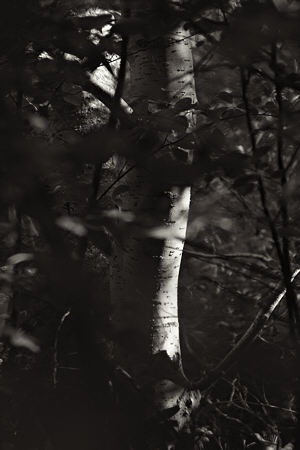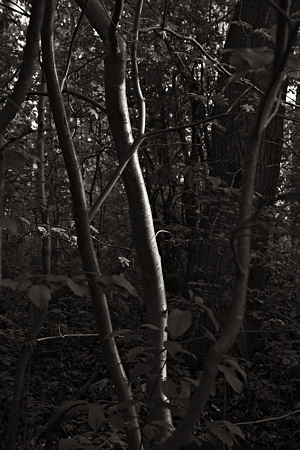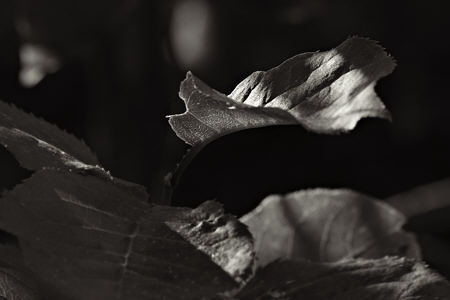In praise of shadows
July 1, 2008
I surprised myself a bit with the photograph in the last post. It has so much dark to it. I’m very fond of darkness in general, but in the context of this series I’ve been fairly diligent in lightening my palette. Actually, I consider it one of my achievements to have learned to tolerate—even embrace on occasion—the burning out of bright areas to pure, shocking, detail-less white.

But I have made a couple other mostly dark photographs in the last month; both were in the side light that is the first or last of the day, and that only reaches in from the edge of the woods in fleeting patches. Realizing this, I was prompted to re-read Junichiro Tanizaki’s essay, In Praise of Shadows. I can strongly sympathize with his idea that “we find beauty not in the thing itself but in the patterns of shadows, the light and the darkness, that one thing against another creates.” In the images here, it is not the illuminated bark itself which attracts me, but the way it glows among obscure and obscuring surroundings.

Tanizaki’s language, though it seems fulsome today, and was already heavy with nostalgia in 1930’s Japan, is nonetheless wonderfully evocative.
Lacquerware decorated in gold is not something to be seen in a brilliant light, to be taken in at a single glance; it should be left in the dark, a part here and a part there picked up by a faint light. Its florid patterns recede into the darkness, conjuring in their stead an inexpressible aura of depth and mystery, of overtones but partly suggested. The sheen of the lacquer, set out in the night, reflects the wavering glow of the candlelight, announcing the drafts that find their way form time to time into the quiet room, luring one into a state of reverie. If the lacquer is taken away, much of the spell disappears from the dream world built by that strange light of candle and lamp, that wavering light beating the pulse of the night. Indeed the thin, impalpable, faltering light, picked up as though little rivers were running through the room, collecting little pools here and there, lacquers a pattern on the surface of the night itself.
In Praise of Shadows is concerned entirely with the interior darkness of home or inn, but the concept certainly carries over to the outdoors, or wherever one spends time. Tanizaki believed that the development of an aesthetic sense lies in our response to the conditions around us:
A light room, would no doubt have been more convenient for us, too, than a dark room. The quality that we call beauty, however, must always grow from the realities of life, and our ancestors, forced to live in dark rooms, presently came to discover beauty in shadows, ultimately to guide shadows towards beauty’s ends.
Filed in: Musings Comments closed
